![]()
|
Sampson
Bridgwood & Son |
Location and period of operation:
|
Sampson
Bridgwood & Son |
Longton |
1820 (1805#) |
1984 |
Earthenware and
china (to
1887) manufacturer in Longton,
Stoke-on-Trent, England
|
| The historian Llewellynn
Jewitt in describing the Market Street Works recorded
"It was here that the late Mr. Sampson Bridgwood made his first start, and after noble struggles against adversity laid the foundation of his ultimate splendid success." Anchor Pottery Llewellynn Jewitt "The ceramic art of Great Britain from pre-historic times down to the present day...." 1878 |
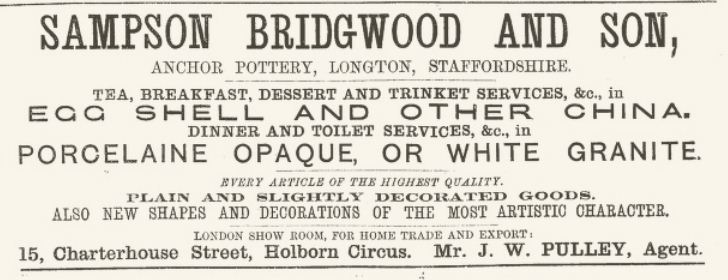
Sampson
Bridgwood & Son
Anchor Pottery, Longton, Staffordshire
The Pottery Gazette, American and Canadian Edition, January 1st 1880
In 1876 both Sampson and his son Samuel died and the business was left to Sampson Bridgwood's daughters, Martha and Mary. From 1879 the business was continued by Mary Walker (née Bridgwood) who bought out her sisters share. Mary Walker's son, George Edward Walker, joined the business in 1880 - they continued to trade as Sampson Bridgwood & Son. |
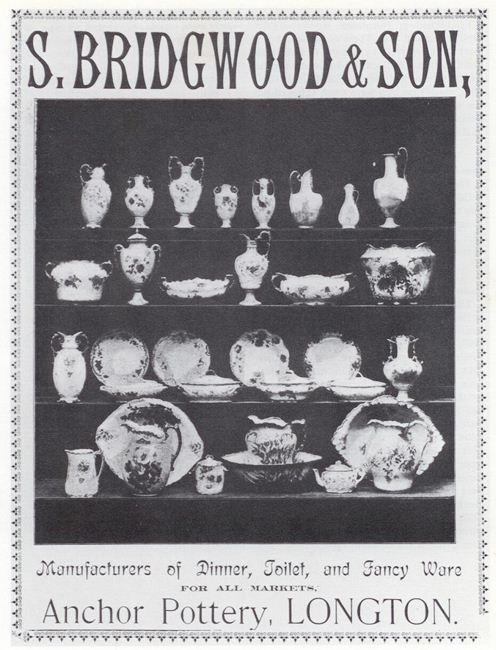
S. Bridgwood & Son
Anchor Pottery, Longton
1896 advert
| The business had run into financial difficulty and by 1887 production of china ware had stopped. In June 1890 the business was placed into receivership. The complete works was bought at auction by the potter John Aynsley and continued to trade as Sampson Bridgwood & Son. |
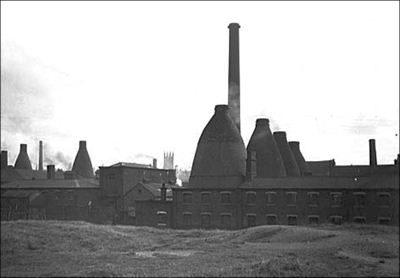
Sampson Bridgwood &
Son's Anchor Pottery- c.1960
- click for more -
Typical examples of ware:
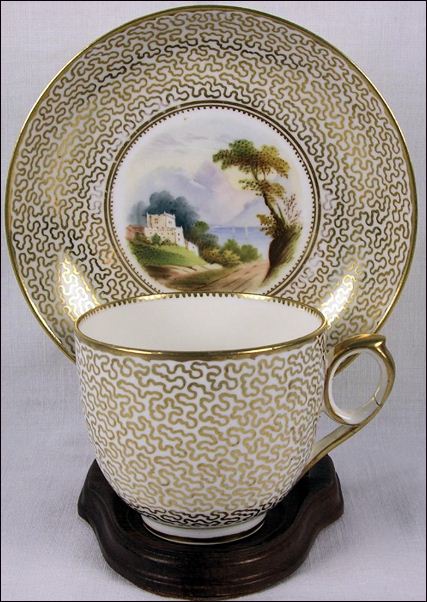
bone china cup & saucer,
hand-enamelled with a castle scene
surrounded by gilded 'Vermicelli' border
impressed mark:
Bridgwood
&
Son
c.1860s
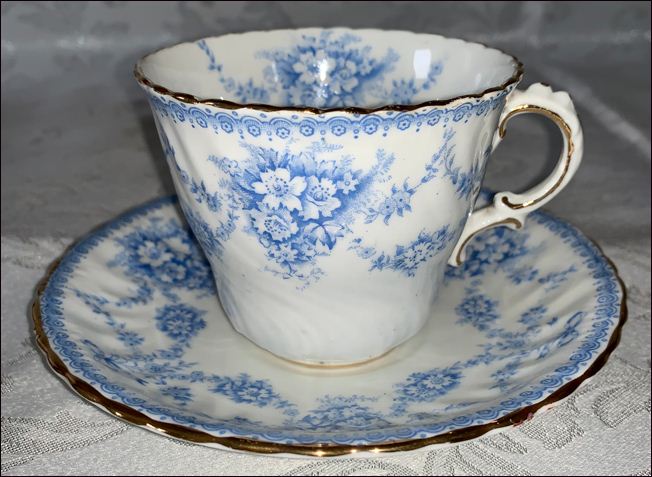
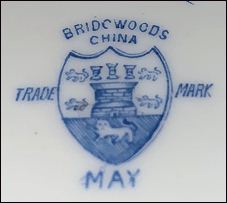
bone china cup & saucer
with blue transfer pattern & gilding
c.1884-87
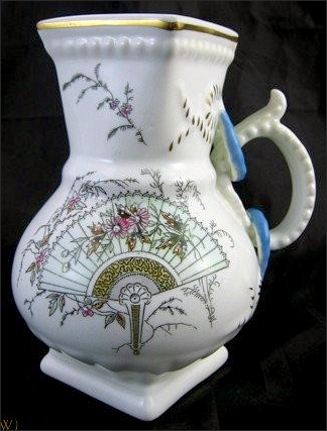
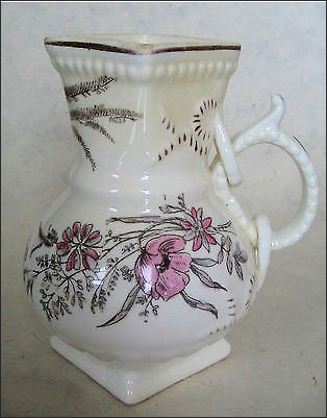

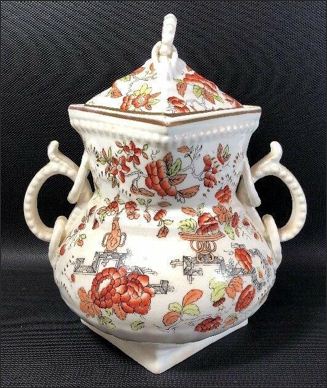
Bridgwood produced a number of style of patterns based on this one shape
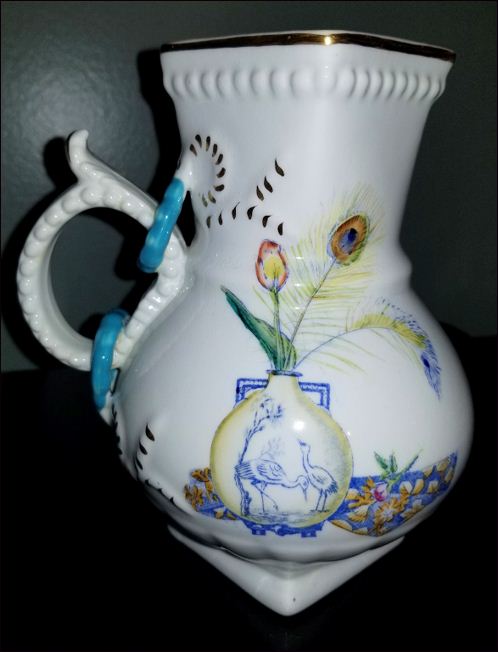 vase - transferware with hand painting & gilding the pattern is in the aesthetic style |
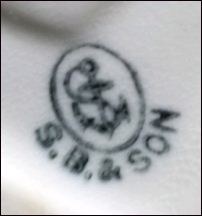 S B & Son c.1885 |
photos courtesy: Donna Baskin
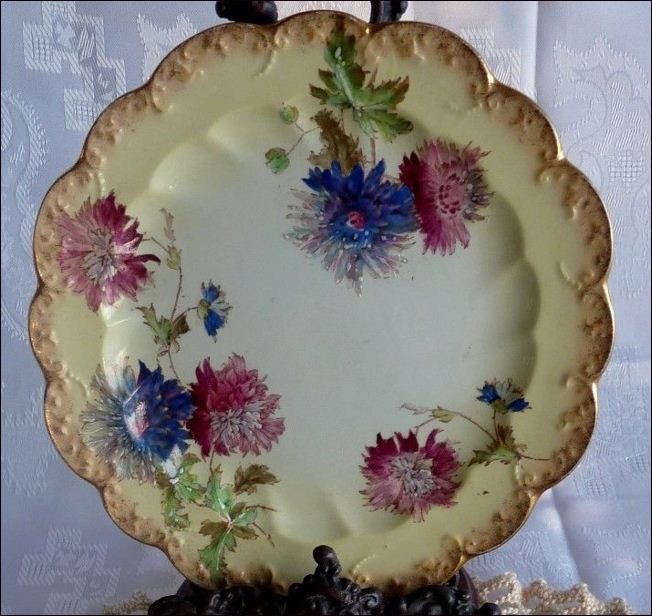 plate in the Chrysanthemum pattern |
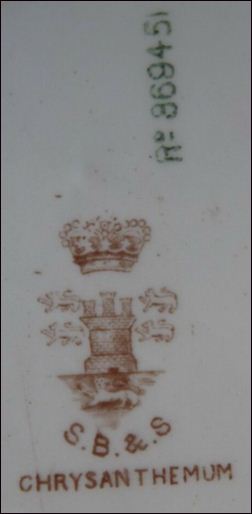 the registration number 369451 shows that the pattern was registered on the 31 January 1901 |
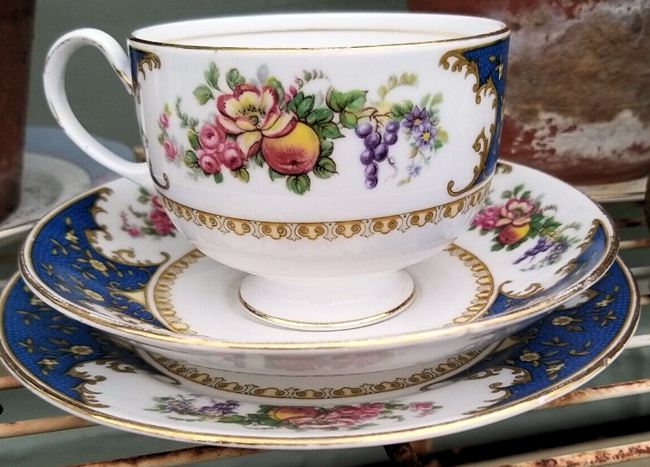 trio produced for the department store Waring & Gillow c.1910+ |
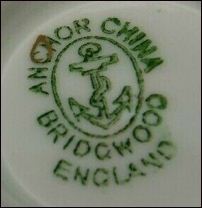 Anchor China Bridgwood England mark on the cup
mark on the plate |
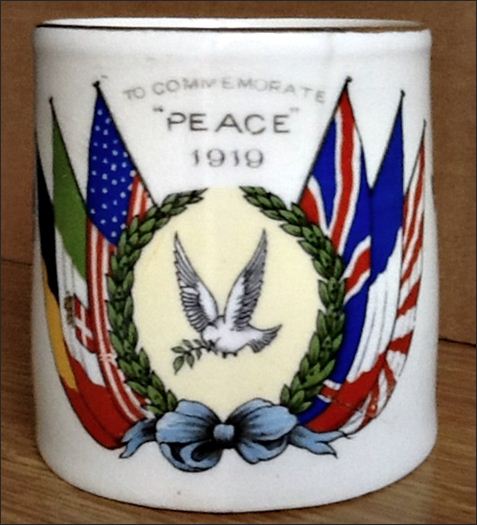 To Commemorate "Peace" 1919 a mug to commemorate the ending the flags of six key Allied powers are
shown (left to right) In
the centre is a dove of peace and the |
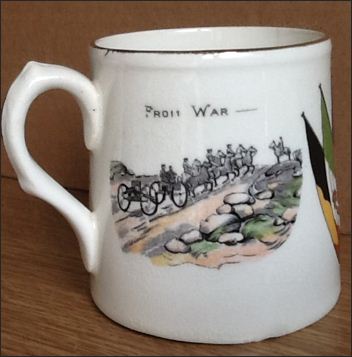 From War....
....they shall beat their swords into plowshares, and their spears into pruninghooks: nation shall not lift up sword against nation, neither shall they learn war any more. (Isaiah chapter 2 verse 4) |
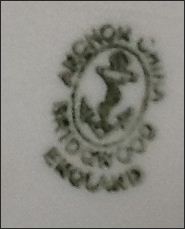 Anchor China Bridgwood England
|
photos courtesy: Diana Graham
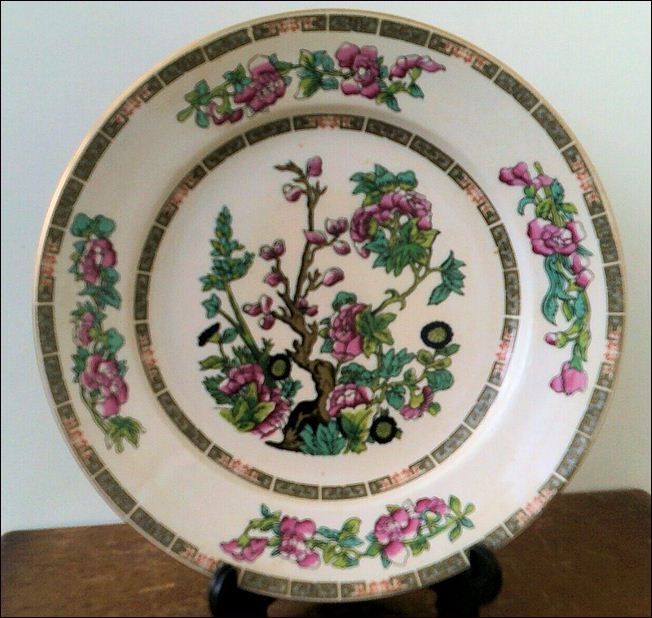 plate in the popular Indian Tree pattern c.1960s |
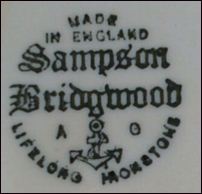 Made in England Sampson Bridgwood Lifelong Ironstone |
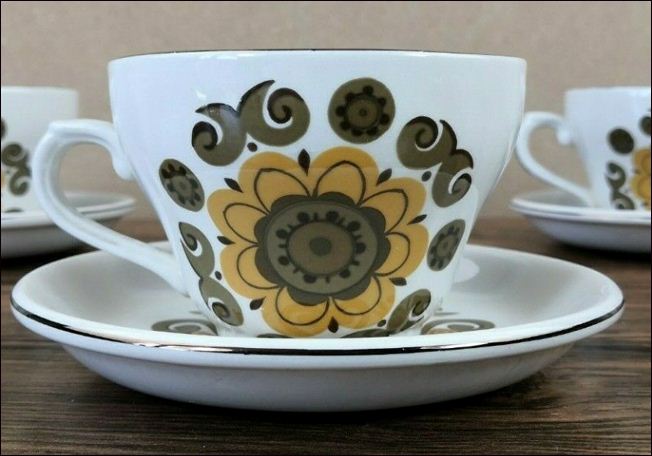 1970s style
|
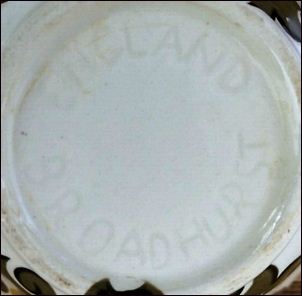
England Broadhurst mark on the cups
mark on the saucers |
Sometimes misattributed
markings:
Samuel
Barker & Son of the Don Pottery in Yorkshire used the initials S.B. & S.
in their marks
- sometimes these are confused with those of Sampson
Bridgwater & Son
|
shield mark with a phoenix |
belt mark with lion holding a pennant
- |
these marks are those of Samuel Barker & Son of the Don Pottery in Yorkshire
Marks used on ware for identification:
Semi-Porcelain
Porcelaine Opaque
Limoges PG
Parisian Granite
| Although Bridgwood & Son stopped producing china in 1887 they continued to use tradenames such as 'semi-porcelain' , 'porcelaine opaque' and 'limoges' for their earthenwares to give an appearance of fine ware. |
BRISGWOOD & SON
S BRIDGWOOD & SON
impressed name marks mid 19th C
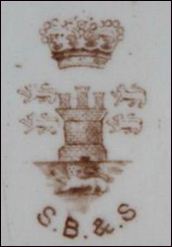
S B & S
printed mark
with crown above a castle
and five lions
c.1853+
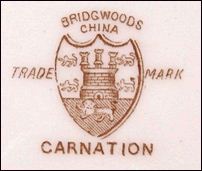
Bridgwoods China
CARNATION is the pattern name
mark introduced from 1884
production of china ceased around 1887
(1917 directory lists this as 'old mark')
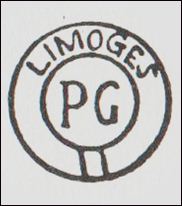
Limoges
PG
'Parisian
Granite' ware
1870+
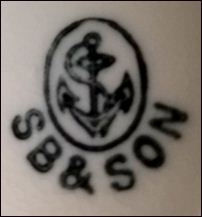
S B & Son
1885+
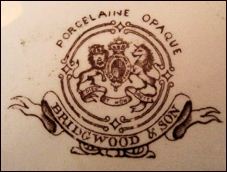 Porcelain Opaque Bridgwood & Son mark incorprating the Royal Arms 1885-1891 |
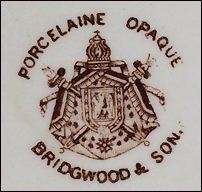 Porcelain Opaque Bridgwood & Son 1885-1891 |
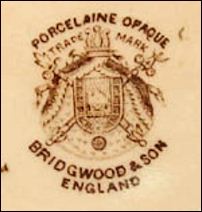 Porcelain Opaque Trade Mark Bridgwood & Son England 1891 + |
marks with 'England' are 1891+

Anchor China Bridgwood England 1910+ |
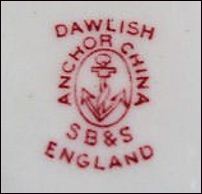
Anchor China S B & S England 1910+ 'DAWLISH' is the pattern namek |
Bridwood stopped producing bone
china in 1887
'Anchor China' was a trade name for fine earthenware
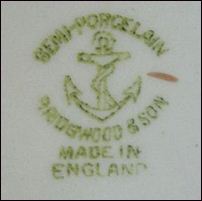 Semi-Porcelain Bridgwood & Son Made in England 1912-32 |
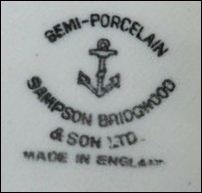 Semi-Porcelain Sampson Bridgwood & Son Ltd Made in England 'Ltd' added from 1933 onward |
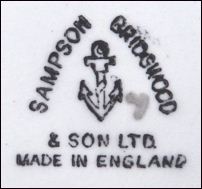 Sampson Bridgwood & Son Ltd Made in England 1950 + |
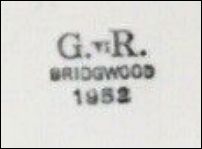
G VI R
Bridgwood
1952
|
The mark shown indicates that the ware was produced for and supplied to the British Government; it was ultimately property of the Crown/Government, hence the GR-VI Cypher. This mark is there to distinguish the piece from being normal ‘utilitarian’ ware for public sale during the period surrounding the Second World War. Bridgwood (and others) were given government contracts throughout the late 1930s and into the 1940s (WWII) and produced canteen ware - most likely for the armed services. The year of manufacturer is generally included. |
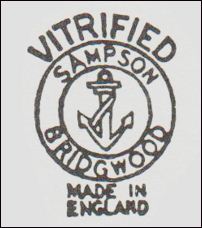
Vitrified
Sampson
Bridgwood
Made in England
1961 +
Mark used on catering ware
 Made in England Sampson Bridgwood Lifelong Ironstone 1965-84 |
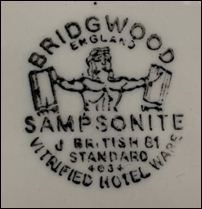 Bridgwood Sampsonite Vitrified Hotel Ware c. late 1970s - 1984 |
The London Gazette
25 September 1821
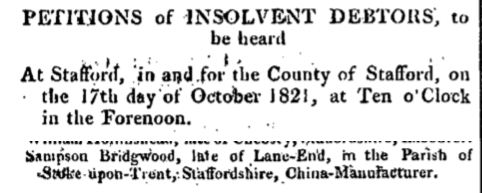
notice of Sampson Bridwood's petition to be made
bankrupt
Sampson Bridgwood was made
insolvent in 1822 and in that
year spent some time in Stafford Gaol as an insolvent debtor
| The historian Llewellynn
Jewitt in describing the Market Street Works recorded "It was here that the late Mr.
Sampson Bridgwood made his first start, and after noble struggles against adversity laid the foundation of his ultimate splendid
success."
Llewellynn Jewitt "The ceramic art of Great Britain from pre-historic times down to the present day...." 1878 |
The London Gazette
11 July 1890
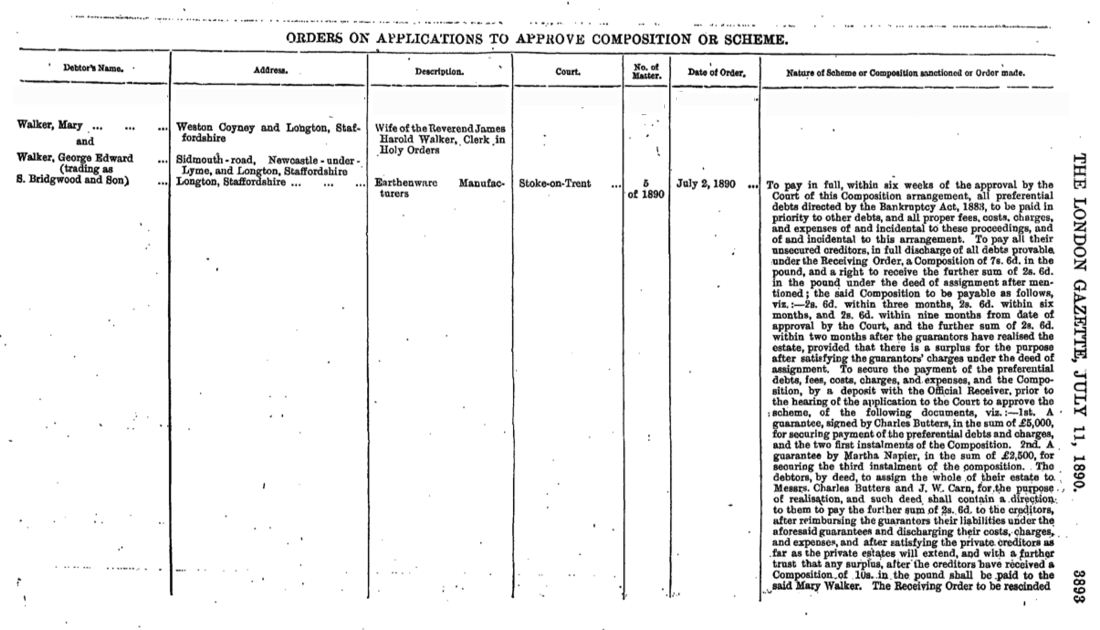
notice of payment scheme to debtor's Mary Walker and
her son George Edward Walker (trading as S. Bridgwood & Son)
the debt was discharged by selling the Anchor Pottery business to John Aynsley

Sampson Bridgwood &
Son's Anchor Pottery- c.1960
- click for more -
Questions, comments, contributions? email: Steve Birks